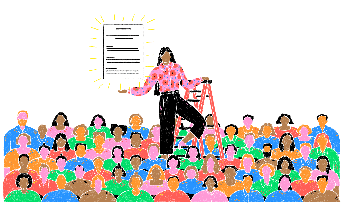
This post is part of TED’s “How to Be a Better Human” series, each of which contains a piece of helpful advice from people in the TED community; browse through all the posts here.
Many trainings and articles about microaggressions focus on how you can intervene in the moment, which is a crucial part of allyship. But in addition to intervening, there are other important ways to support people who experience microaggressions, systemic inequities and other barriers to opportunity — and one way is through microafffirmations.
In contrast to microaggressions, microaffirmations are little ways that you can affirm someone’s identity; recognize and validate their experience and expertise; build confidence; develop trust; foster belonging; and support someone in their career. Microaffirmations can help mitigate and disrupt the harmful effects of historical oppression, systemic inequity, cultural marginalization and personal biases.
Here are some to try:
Keep an eye out for key moments that might be important in someone’s life, and recognize them.
Microaffirmation #1: Get to know people, and pay close attention to their words and ideas
Show genuine curiosity and compassion about the lives and work of your team members and colleagues. Build relationships with them so you can better collaborate together and advocate for each other. When they are speaking, listen and be fully present. And when they are sharing their ideas or experiences, make sure you show compassion and empathy.
Microaffirmation #2: Mirror the language that someone uses to describe their own identity
Listen and learn how someone pronounces their name, describes their identity and uses their pronouns. Then mirror the language they use to describe themselves — it shows them you’re paying attention and that you care about them.
Microaffirmation #3: Acknowledge important religious and cultural holidays and life milestones
Keep an eye out for key moments that might be important in someone’s life, and recognize them. You might wish them a lovely Diwali if they celebrate it, or make a note on your workplace intranet about Indigenous People’s Day, Transgender Day of Remembrance, National Coming Out Day, Black History Month, Juneteenth, Ramadan, Lunar New Year, Disability Employment Awareness Day, Pride Month, Yom Kippur, Holocaust Remembrance Day, International Women’s Day, Hispanic Heritage Day, Deaf History Month and so on.
Birthdays, births, graduations, promotions and weddings are also nice moments for you to send a quick note. And make sure you check in during harder life moments too, such as deaths and illnesses.
A person who is feeling marginalized or excluded, tokenized or like an impostor may sideline themselves — by not speaking up, not contributing, not showing up.
Microaffirmation #4: Work hard to encourage participation from everyone on your team
Solicit ideas and feedback on projects. If you’re leading a meeting or a project, explicitly invite participation from everyone, and if someone has not contributed, invite them to share their thoughts either in the moment or afterward.
Microaffirmation #5: When someone isn’t participating, take notice and support them
A person who is feeling marginalized or excluded, tokenized or like an impostor may sideline themselves — by not speaking up, not contributing, not showing up. In the remote workplace, people may turn off their video because they aren’t engaged, don’t have a home environment they want to show on video, feel excluded, or are burned out from inequities and exclusion. Check in with them, and see if and how you can support them.
Microaffirmation #6: Acknowledge people’s expertise and skill
People with underrepresented identities often find their expertise and skills are regularly questioned and held to higher standards. Make it a point to acknowledge their expertise and skills, and solicit their opinions and ideas.
In one study, nearly two-thirds of women and people of color in engineering reported having to prove their expertise repeatedly, compared to 35 percent of white men — their expertise was questioned, their successes were discounted, and they were often pressured to let white men take the lead, while at the same time they were asked to do office housework.
Knowing these biases exist, recognize when someone’s expertise and ideas are being questioned and counter that by acknowledging their expertise and giving them opportunities t0 shine.
If you’ve been invited to give a speech or presentation, ask if you can bring an expert colleague with you to the stage.
Microaffirmation #7: Recognize people’s achievements
One of the best ways to share with your colleagues, team members and the world what someone has accomplished is by recognizing their achievements. This could be in small ways, like recognizing someone’s integral work on a project in conversation, or in larger ways — such as in public communications or awards.
Microaffirmation #8: Amplify their voices
Use your platform to amplify someone else’s ideas and story — this could be in marketing, communications, presentations, reports, verbal storytelling, vendor management and procurement, product and service design, or some other way that your platform can elevate new voices and ideas. Make sure you credit those ideas and voices, elevate their status, and share your influence.
Women — and especially women of color — tend to receive less quality feedback that can help them make needed course corrections and develop as leaders.
Microaffirmation #9: Invite someone to speak and share their expertise
If you’ve been invited to give a speech or presentation, ask if you can bring an expert colleague with you to the stage, or consider stepping back and recommending someone who isn’t often asked to speak.
However, as someone who has done this many times, I’ve learned that if someone is experiencing impostor syndrome or if they are dealing with a lot in their life, they may say no or not respond to your invitation. Try again, and let them know why you want their expertise. And if you’re
asking someone to share their expertise at a corporate event or at an event that makes a profit, make sure they are paid equitably for their expertise.
Microaffirmation #10: Provide regular and quality formal and informal feedback
Women — and especially women of color — tend to receive less quality feedback that can help them make needed course corrections and develop as leaders. This can be due to stereotypes or avoidance, where managers are uncomfortable or fearful of how someone might receive their comments.
When women do receive formal feedback, it is often about their communication styles (for example, you’re too aggressive or not assertive enough, or your speaking style can be off-putting) rather than actionable developmental feedback about skills (for example, you could deepen your knowledge about skill X, which will help you in Y way).
Microaffirmation #11: Establish ahead of time what behaviors and skills demonstrate proficiency and leadership in a role
Tie progress and feedback to team and business goals, use the same feedback criteria for everyone in that role, and develop a plan with each person to improve their skills and navigate career progression. Also give people quality feedback on presentations, projects and leadership moments.
Microaffirmation #12: Provide both positive feedback and constructive criticism
When I was in film school working with actors, one of my directing teachers taught us that you should always give an actor two to three pieces of specific positive feedback before providing negative or constructive feedback. It can make a big difference in their next performance: You build their confidence, help them learn what works and then ask them to try something new.
Microaffirmation #13: Provide subtle feedback in presentations and idea sharing
Even on a video call or in a meeting when you’re not speaking, your facial expressions and body language can be an important source of feedback for others. Make sure you are fully present when someone is sharing, and think about the message you’re conveying nonverbally.
You can nod, show you’re thinking and taking in their ideas, indicate you want to know more, let them know you’re confused by one of their points, and so on.
Excerpted from the new book How to Be an Ally: Actions You Can Take for a Stronger, Happier Workplace by Melinda Briana Epler. © 2021 Melinda Briana Epler. Published by McGraw Hill.
Watch her TED Talk here:












